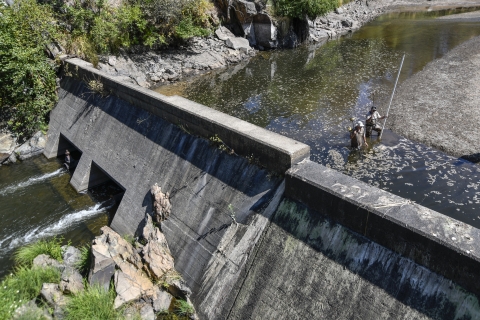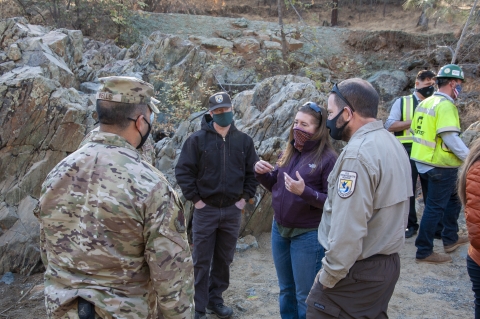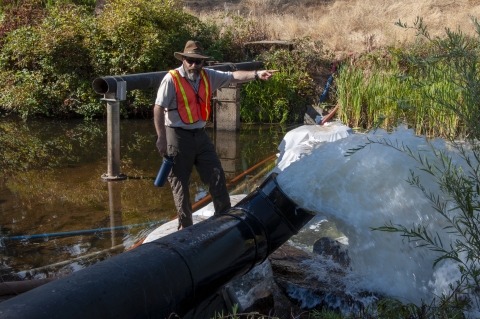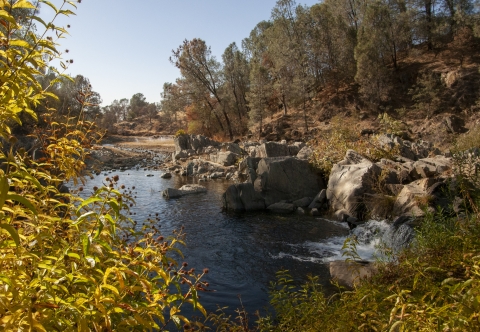In 1943 the Army completed a dam on Camp Beale so its soldiers could fish, swim and jump off the dam’s diving platform. Nearly 80 years later, the Air Force is giving Dry Creek back to the original tenants: its fish.
“The dam was built to provide recreation,” said Paul Cadrett, a fish biologist and habitat restoration coordinator for the U.S. Fish and Wildlife Service in Lodi, California. “Then in the ’80s someone said, ‘Hey, there are fish banging their heads at the bottom of this dam,’ so they built a fish ladder. But it didn’t work very well, and most fish weren’t able to navigate it.”
The ladder was undersized, and the design used in the 1980s is outdated. Some fish made it upstream to the state’s Spenceville Wildlife Area, but many more, including threatened Central Valley steelhead, were blocked by the 12-foot obstruction.
The dam was originally built in conjunction with an Army officers club, but the club is long gone, swimming hasn’t been allowed for decades, and there’s better fishing elsewhere on the base, which was transferred to the Air Force and renamed in 1948.
In 2015, at Beale Air Force Base’s request, the Service began a habitat assessment, which showed that tearing down the dam and restoring Dry Creek would be less expensive than installing and maintaining a new fish ladder. By then, the Air Force was ready to part with the dam.
“It’s removing something that’s not really functional for us anymore and was actually going to be a hazard,” said Tamara Gallentine, natural and cultural resources program manager for Beale Air Force Base. “The dam really needed some repairs. It was starting to have some cracks in it … and we have whole trees coming down that creek sometimes. In the winter when we have high flows, it’s really moving.”
Beale, under the Sikes Act of 1960, works with the Service, National Oceanic and Atmospheric Administration Fisheries, and the California Department of Fish and Wildlife to manage, conserve and rehabilitate natural resources on base. The installation also carries out programs, as required by the Endangered Species Act, to conserve endangered or threatened species like the Central Valley steelhead.
The dam removal and creek restoration project was carried out with Air Force funding and Service expertise. The new creek channel was designed by Service engineers from Alaska and Massachusetts, who surveyed a section (or “reach”) of the creek upstream of the restoration area to use as a model.
“You want to look at the characteristics of the reference reach in terms of, ‘What are the dimensions of a riffle, what are the dimensions of a pool, how sinuous or how curvy is the channel?’” said Jessica Pica, a Service fish passage fish passage
Fish passage is the ability of fish or other aquatic species to move freely throughout their life to find food, reproduce, and complete their natural migration cycles. Millions of barriers to fish passage across the country are fragmenting habitat and leading to species declines. The U.S. Fish and Wildlife Service's National Fish Passage Program is working to reconnect watersheds to benefit both wildlife and people.
Learn more about fish passage engineer in Massachusetts who worked on the project. “Then we apply that information to our site when designing the project.”
Pica and her colleagues also designed a “rocky ramp” to help salmonids over a small natural waterfall upstream of the dam. The slope simulates a natural creek bed, but its dimensions are based on Chinook salmon swimming and jumping ability.
The ramp provides passage upstream and rocks for fish to rest behind while they gain elevation to arrive at a waterfall-fed pool. The high end of the ramp also acts like a dam, ensuring the pool’s water level is high enough for fish to jump over the waterfall.
“The goal is to raise the water surface elevations and create a jumping pool so fish are able to navigate over the waterfall,” Pica said. “We played with different slopes and dimensions to get [a ramp] that worked.”
With this new path, Cadrett expects steelhead and salmon to pass through Dry Creek into Spenceville in much greater numbers.
The Air Force, the Department and the Service plan to further restore Dry Creek in the future by injecting gravel into Spenceville upstream of the base and removing a fish barrier on private land downstream.
“Fish are amazingly resilient. If we get good water conditions, we can draw steelhead up here,” Cadrett said. “A lot of people have this thought that salmon and steelhead will only go back to their own river to spawn, but that’s not completely true…this allows salmon and steelhead to recolonize areas where they might have been extirpated from.”
On the banks of the new channel on Beale, crews planted a variety of native vegetation to prevent erosion, attract birds and insects, and provide shade to help maintain fish-friendly water temperatures. They also reinforced the piers of a pedestrian bridge that crosses over the creek, so the bridge is safe without the dam’s support. In addition to providing great views, the bridge connects visitors with a nature trail on its south end.
“It’s a great fishing hole, and lots of people enjoy it,” Gallentine said. “Now instead of having a small pond to fish in, they’ll have a creek — a little different style of fishing — and they’ll be able to get closer to the creek and see the fish up close.”







